INTRODUCTION
|
| In Mobile Ad hoc Network (MANET) the nodes can get the service using random mobility model to communicate each other in the network. There is no centralized service to network [1]i.e. No base station service to mobile node, due to high mobility in network link failure and the routing path cannot be define constantly for data transmission , so data loss and path failure is the major issues in MANET. Dynamic routing leads to improper neighbor selection to reach destination. |
| Broadcasting is a fundamental and effective data dissemination mechanism for route discovery, address resolution and many other network services in ad hoc networks. While data broadcasting has many advantages, it also causes some problems such as the broadcast storm problem, which is characterized by redundant retransmission, collision, and contention. |
Why Re-Broadcasting Needed?
|
| In MANET, A node forward the rebroadcasting packet based on the current node which didn't receive the broadcast message, there rebroadcasting packet exists, which provide the service to activate the sleeping node in the routing [1]. It mainly helps to cover the neighbor activeness for routing, which gives the results to reduce the redundancy over re- broadcasting. |
| To optimize the broadcasting, we can limit the number of rebroadcasting in the routing [2]. Rebroadcasting delay helps to define the neighbor coverage knowledge in network [3], in order to strengthen the network connectivity, broadcasting neighbors should receive the RREQ packet [2] these reduce the redundant and number of rebroadcasts of the RREQ packet in the data transmission [3]. |
| To discover the route better than broadcasting methodology, rebroadcasting is done with the help of neighbor knowledge methods. In order to effectively exploit the neighbor coverage knowledge, a novel rebroadcast delay and a connectivity factor to provide the node density adaptation is calculated. This NCPR protocol does not focus on spectrum utility efficiently which helps in improving the performance of the protocol. |
| Cognitive Radio Routing: The concept of Cognitive radio Routing is used here identifying valid neighbors in order to reduce number of neighbors for faster transmission of rebroadcasting packets. Devices with cognitive capabilities can be networked to create Cognitive Radio Networks (CRNs), which are recently gaining momentum as viable architectural solutions to address the limited spectrum availability and the inefficiency in the spectrum usage [8]. |
| The most general scenario of CRNs distinguishes two types of users sharing a common spectrum portion with different rules: Primary (or licensed) Users (PUs) have priority in spectrum utilization within the band they have licensed, and Secondary Users (SUs) must access the spectrum in a non-intrusive manner. Primary Users use traditional wireless communication systems with static spectrum allocation. Secondary Users are equipped with CRs and exploit Spectrum Opportunities (SOPs) to sustain their communication activities without interfering with PU transmissions. |
Routing challenges in multi-hop CRNs
|
| The reference network model reported in Fig. 1 features secondary devices which share different spectrum bands (or SOPs) with primary users. Several spectrum bands (1, . . . , M) may exist with different capacities C1, C2, CM, and the SUs may have different views of the available spectrum bands due to inherent locality of the spectrum sensing process. Typically the PUs are assumed motionless while the SUs may vary their position before and during a transmission. |
| In this scenario, the problem of routing in multi-hop CRNs targets the creation and the maintenance of wireless multi-hop paths among SUs by deciding both the relay nodes and the spectrum to be used on each link of the path. Such problem exhibits similarities with routing in multi-channel, multi-hop ad hoc networks and mesh networks, but with the additional challenge of having to deal with the simultaneous transmissions of the PUs which dynamically change the SOPs availability. In a nutshell, the main challenges for routing information throughout multi-hop CRNs include: |
| • the spectrum-awareness; |
| • the setup of ‘‘quality” routes in dynamic variable environment; |
| • the route maintenance/reparation; |
Adaptation Of Cognitive Radio for neighbor identification
|
| A common approach of including Cognitive radio concept into routing protocol is by inserting spectrum-related information, such as spectrum opportunity (SOP), channel usage list, etc., of the SUs into the routing control packets. In the route discovery, this spectrum-related information is piggybacked on the control packets (RREQ, RREP, and RERR). For example, the source node may insert its spectrum-related information on RREQ packets. When the intermediate nodes forward the RREQ packets, they also include their own spectrum-related information. Then, usually the destination node gets to decide the spectrum band to be used for data transfer. It assigns the spectrum, encapsulates it in RREP, and sends it back to the source node. Likewise, intermediate nodes that receive RREP assign the spectrum bands (Figure 2). Hence, on RREQ and RREP forwarding, the packets are getting larger in size with agreement with the hop or distance between the source and destination. |
RELATED WORKS
|
| The routing overhead occurred because of the dissemination of routing control packets such as RREQ packets can be quite huge, especially when the network topology frequently changes. Traditional on-demand routing protocols produce a large amount of routing traffic by blindly flooding the entire network with RREQ packets during route discovery. Recently, the issue of reducing the routing overhead associated with route discovery and maintenance in on demand routing protocols has attracted increasing attention. |
| Huang [10] proposed a methodology of dynamically adjusting the Hello timer and the Timeout timer according to the conditions of the network. For example, in a high mobility network (with frequent topology changes) it is desirable to use small values for the timers to quickly detect the changes in the network. On the other hand, in a low mobility network where the topology remains stable and with few changes, a large value for the timers is more effective to reduce the overhead. In order to decide whether the mobility of the network is high or low, we use a simple way to approximate in real time of the link change rate. The reduction of the overhead is greatly achieved with the minimal cost of slightly increasing the drop rate in data traffic. While the packet loss increases around 1%, the overhead reduction reaches 40%. |
| Ould-Khaoua [11] proposed two new probabilistic route discovery method, called Adjusted Probabilistic route discovery(AP) and Enhance Adjusted Probabilistic route discovery (EAP) which addresses the broadcast storm problem in the existing on - demand routing protocols. The forwarding probability is determined by taking into account about the local density of the sending node. |
| In order to reduce the routing overhead without degrading the network throughput in dense networks, the forwarding probability of nodes located in sparse areas is set high while it is set low at nodes located in dense areas. EAP - AODV reduces overhead by 71% while AP - AODV reduces the overhead by 55%. |
| Aminu[12] proposed a rebroadcast probability function which takes in to account about the value of the packet counter together with some key simulation parameters(i.e. network topology size, transmission range and number of nodes) to determine the appropriate rebroadcast probability for a given node. The rebroadcast probability of a node is computed based on these parameters. Compared to the other schemes, simulation results have revealed that counter Function achieved superior saved rebroadcast (about 20% better than its closest competitor i.e., counter-based scheme, in dense network) and end-to-end delay (around 26% better than counter-based scheme in dense network) without sacrificing reach ability in medium and dense networks. |
NEIGHBOUR COVERAGE BASED PROBABILISTIC REBROADCAST USING COGNITIVE RADIO PARADIGM
|
| This paper focuses on improving the neighbor coverage based probabilistic rebroadcast protocol [2] which combines both neighbor coverage and probabilistic methods. The improving mechanism focuses on identifying selected set of neighbors based on spectrum availability for faster transmission of packets and thereby improving the efficiency and performance of the protocol. |
| In order to effectively exploit the neighbor coverage knowledge, we need a novel rebroadcast delay to determine the rebroadcast order, and then we can obtain a more accurate additional coverage ratio. In order to keep the network connectivity and to reduce the redundant retransmissions, we need a metric named connectivity factor to determine how many neighbors should receive the RREQ packet [14]. After that, by combining the additional coverage ratio and the connectivity factor, we introduce rebroadcast probability, which can be used to reduce the number of rebroadcasts of the RREQ packet and to improve the routing performance. |
COGNITIVE RADIO BASED NEIGHBOR IDENTIFICATION
|
| Rebroadcasting of packets is necessary whenever there is a link breakage on existing transmission of data between source and destination .It requires a route discovery process starting with a route request (RREQ) broadcasted by the source to neighbors on each channel not affected by a PU activity and ends with a route set up after the reception of a route. Here an intermediate CU is supposed to receive and handle RREQs and RREPs among a subset of the l channels reply (RREP) from the destination, as shown by the flow charts depicted in Fig. 3 and 4. |
| More in detail, when an intermediate CU receives the first RREQ through a channel free from PU activity, say channel l, it sets up a reverse path toward the sender CU through the same channel. If the receiving CU can supply a valid route for the desired destination, then it sends a unicast route reply (RREP) back to the sender through the same channel. Otherwise, it broadcasts a copy of the RREQ packet through the channel |
| If an additional RREQ is received through the same channel, the CU checks if the RREQ is newer or it refers to a better reverse route than the one stored in the routing table. In both cases the node updates the reverse path and it sends a RREP or it broadcasts the RREQ, differently the node simply discards the packet. We note that, since the route discovery processes associated with each channel are independent each other, it can happen that routes on different channels can be composed by different intermediate nodes. |
| When an intermediate CU receives the first RREP through a free channel, say it sets up a forward route through the same channel toward the RREP sender and it forwards a copy of the RREP along the reverse path through channel. |
| If an additional RREP will be received through channel l, the CU will update the forward path only if the RREP is newer or it refers to a better forward route. The route maintenance process aims to react to topology changes due to node mobility or wireless propagation instability as it occurs for existing protocol. However, differently from that a route error can be also due to a PU |
| which starts to use a channel previously available. Therefore, two classes of route error (RERR) messages are mentioned: usual RERRs for handling topology changes and PU-RERRs for handling PU activity, as shown by the flow chart of Fig. 3. |
| When a PU activity is detected by a node in a channel, say l , the node invalidates all the routing entries through such a channel and it informs the neighbor CUs that channel l is now unavailable with a PU-RERR packet. The CUs that receive such a packet invalidate the channel l route entries whose next hop is the PU-RERR source. In such a way, only the nodes effectively affected by the PU activity must release the busy channel. |
| We note also that, unlike usual RERRs, the scope of the PU-RERR packets is local, since they are never re-forwarded and they do not rise to new route requests. This allows the existing protocol to limit the overhead in case of frequent changes in the activity of the PUs. As a consequence, it an happen that a data packet reaches an intermediate CU whose entry has been invalidated with a PU-RERR, and in such a case a usual RERR is broadcasted by the intermediate CU. On the other hand, when a node senses that a previously occupied channel becomes available, it re-validate the stored routing entries through channel l so that incoming data packets may be forwarded along such a channel. We underline that no control packets are sent in such a case. As regards to the packet forwarding process, in order to maximize the spectrum efficiency, this method exploits all the available channels to improve the overall performances. |
| To this aim, each forwarder, at the first, singles out the shortest available paths for the destination, then, it selects by chance one of the shortest paths and forwards the data packet through it. In such a way, this scheme not only benefits from spectral diversity increasing the packet delivery ratio, but it also keeps active all the shortest routes. |
REBROADCAST DELAY
|
| In order to effectively exploit the neighbor coverage knowledge, we need a novel rebroadcast delay to determine the rebroadcast order, and then we can obtain a more accurate additional coverage ratio. In order to keep the network connectivity and to reduce the redundant retransmissions, we need a metric named connectivity factor to determine how many neighbors should receive the RREQ packet [14]. After that, by combining the additional coverage ratio and the connectivity factor, we introduce rebroadcast probability, which can be used to reduce the number of rebroadcasts of the RREQ packet and to improve the routing performance. |
| The rebroadcast delay is to determine the forwarding order. The node which has more common neighbors identified using Cognitive Radio concept with the previous node has the lower delay. If this node rebroadcasts a packet, then more common neighbors will know this fact. Therefore, this rebroadcast delay enables the information about the nodes which have transmitted the packet to more neighbors, which is the key success for the proposed scheme. When a node ni receives an RREQ packet from its previous node s, node s can use the neighbor list in the RREQ packet to estimate how many its neighbors have not been covered by the RREQ packet . If node ni has more neighbors uncovered by the RREQ packet from s, which means that if node ni rebroadcasts the RREQ packet, the RREQ packet can reach more additional neighbor nodes. When node s sends an RREQ packet, all its neighbors ni, i = 1, 2 …receive and process the RREQ packet. We assume that node nk has the largest number of common neighbors with node s, node nk has the lowest delay. Once node nk rebroadcasts the RREQ packet, there are more nodes to receive the RREQ, because node nk has the largest number of common neighbors. Node nk rebroadcasts the RREQ packet depends on its rebroadcast probability calculated in the next subsection. The objective of this rebroadcast delay is not to rebroadcast the RREQ packet to more nodes, but to disseminate the neighbor coverage knowledge more quickly. After determining the rebroadcast delay, the node can set its own timer. |
REBROADCAST PROBABILITY
|
| This scheme considers the information about the uncovered neighbors, connectivity metric and local node density to calculate the rebroadcast probability. The rebroadcast probability is composed of two parts: |
| a) additional coverage ratio, which is the ratio of the number of nodes that should be covered by a single broadcast to the total number of neighbors, and |
| b) connectivity factor, which reflects the relationship of network connectivity and the number of neighbors of a given node. |
| The node which has a larger rebroadcast delay may listen to RREQ packets from the nodes which have lowered one [14]. We do not need to adjust the rebroadcast delay because the rebroadcast delay is used to determine the order of disseminating neighbor coverage knowledge. When the timer of the rebroadcast delay of node in expires, the node obtains the final uncovered neighbor set. The nodes belonging to the final uncovered neighbor set are the nodes that need to receive and process the RREQ packet. Note that, if a node does not sense any duplicate RREQ packets from its neighborhood, its uncovered neighbor set is not changed, which is the initial uncovered neighbor set. Now we study how to use the final uncovered neighbor set to set the rebroadcast probability. The metric Ra indicates the ratio of the number of nodes that are additionally covered by this rebroadcast to the total number of neighbors of node ni. The nodes that are additionally covered need to receive and process the RREQ packet. As Ra becomes bigger, more nodes will be covered by this rebroadcast, and more nodes need to receive and process the RREQ packet, and, thus, the rebroadcast probability should be set to be higher. |
| Xue [13] derived that if each node connects to more than 5.1774 log n of its nearest neighbors, then the probability of the network being connected is approaching 1 as n increases, where n is the number of nodes in the network. Then we can use 5.1774 log n as the connectivity metric of the network. We assume the ratio of the number of nodes that need to receive the RREQ packet to the total number of neighbors of node ni is Fc(ni). |
| If the local node density is low, the parameter Fc increases the rebroadcast probability, and then increases the reliability of the NCPR in the sparse area. If the local node density is high, the parameter Fc could further decrease the rebroadcast probability, and then further increases the efficiency of NCPR in the dense area. Thus, the parameter Fc adds density adaptation to the rebroadcast probability. |
| In this section, we calculate the rebroadcast delay and rebroadcast probability of the proposed protocol. We use the upstream coverage ratio of an RREQ packet received from the previous node to calculate the rebroadcast delay, and use the additional coverage ratio of the RREQ packet and the connectivity factor to calculate the rebroadcast probability in our protocol, which requires that each node needs its 1-hop neighborhood information. |
Algorithm 1
|
| The algorithm describes the rebroadcast delay description for the node ni |
| Neighbor knowledge obtained using Cognitive Radio concept; |
| Rebroadcast Delay () |
| { |
| IF node ni receives RREQ from previous node s |
| Use neighbor list table to see the uncovered neighbors from s |
| THEN |
| IF RREQ comes for the first time |
| Find neighbor node knowledge |
| ELSE |
| Discard RREQ message |
| END IF |
| FOR every RREQ node s sends RREQ to neighbors of ni, i=1, 2… |
| DO |
| Assume nk has lowest delay |
| nk will rebroadcast based on Rebroadcast Probability which is find from Algorithm 2 |
| END FOR |
| END IF |
| } |
Algorithm 2
|
| The algorithm describes to set the Rebroadcast Probability |
| Rebroadcast Probability () |
| { |
| IF node ni receive duplicate RREQ from neighbor node nj |
| THEN |
| ni knows how many neighbors have been covered by RREQ from nj |
| ni adjusts its uncovered neighbor set according to neighbor list |
| SET a reschedule timer for node ni |
| IF timer expires |
| Node ni obtains final uncovered neighbor set |
| THEN Uncovered neighbor set nodes need to receive and process RREQ |
| FOR each uncovered neighbor set |
| DO |
| Calculate |
| Number of nodes that are additional covered by rebroadcast |
| ---------------------------------------------------------= Fc (ni) |
| Total number of neighbors of node ni |
| = Node density |
| IF Fc (ni) is low |
| THEN SET Rebroadcast Probability as high |
| ELSE |
| SET Rebroadcast Probability as low |
| END IF |
| END FOR |
| END IF |
| } |
CONCLUSION
|
| MOBILE ad hoc networks (MANETs) consist of a collection of mobile nodes that can be dynamically self-organized into arbitrary topology networks without a fixed infrastructure. Broadcasting is a fundamental and effective data dissemination mechanism in route discovery. But it causes the broadcast storm problem. To reduce the deleterious impact of flooding RREQ packets, a number of route discovery algorithms have been suggested over the past few years. One of the fundamental challenges of MANETs is the design of dynamic routing protocols with good performance and less overhead. |
| This paper proposes a Cognitive Radio based neighbor identification for faster re transmission of Re Broadcasting packets. This identified neighbor set is used as Uncovered neighbor list in probabilistic Rebroadcast protocol and thus routing overhead is reduced and performance of the protocol is further improved. |
| |
Figures at a glance
|
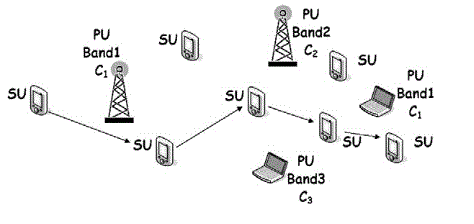 |
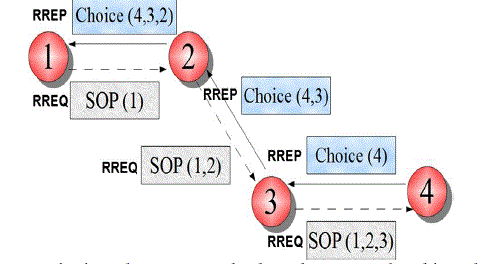 |
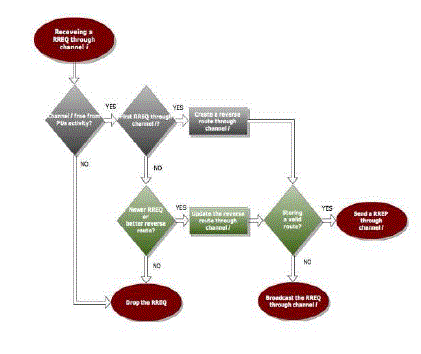 |
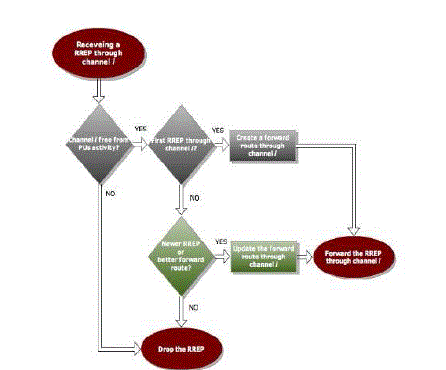 |
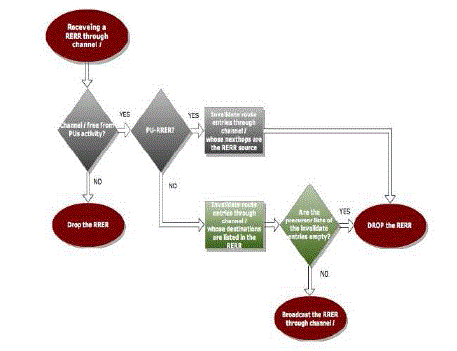 |
| Figure 1 |
Figure 2 |
Figure 3 |
Figure 4 |
Figure 5 |
|
| |
References
|
- C. Perkins, E. Belding-Royer, and S. Das, “Ad hoc On-Demand Distance Vector (AODV) Routing,” RFC 3561, 2003.
- Xin Ming Zhang,En Bo Wang, Jing Jing Xia, and Dan KeunSung,“ANeighbour Coverage based Probabilistic Rebroadcast for Reducing Routing Overhead in
- Mobile Ad hoc Networks” Mobile Computing, IEEE Transactions on VOL. 11, NO. Jan, 2012.
- J. Kim, Q, Zhang, and D. P. Agrawal, “Probabilistic Broadcasting Based on Coverage Area and Neighbour Confirmation in Mobile Ad hoc Networks,” Proc. of IEEE GLOBE COM’ 04, 2004.
- F.C. Commission, Spectrum policy task force, Technical report, November 2002.
- E. Buracchini, The software radio concept, IEEE Communication Magazine 38 (9) (2000) 138–143.
- J. Mitola, Cognitive radio, An Integrated Agent Architecture for Software Defined Radio, PhD Dissertation Thesis, KTH, Sweden.
- I.F. Akyildiz, W.Y. Lee, M. Vuran, S. Mohanty, A survey on spectrum management in cognitive radio networks, IEEE Communication Magazine 46 (4) (2008) 40–48.
- I.F. Akyildiz, W.-Y. Lee, M.C. Vuran, S. Mohanty, Next generation/ dynamic spectrum access/cognitive radio wireless networks: a survey, Computer Networks FCC, FCC 08-260, Unlicensed Operation in the TV Broadcast Bands, November 2008.
- D. Johnson, Y. Hu, and D. Maltz, “The Dynamic Source Routing Protocol for Mobile Ad hoc Networks (DSR) for IPv4,” RFC 4728, 2007.
- X. Wu, H. R. Sadjadpour, and J. J. Garcia-Luna-Aceves, “Routing Overhead as A Function of Node Mobility: Modeling Framework and Implications on Proactive Routing,” Proc. of IEEE MASS’07, pp. 1-9, 2007.
- Mohammed, M. Ould-Khaoua, L.M. Mackenzie, C. Perkins, and J. D. Abdulai, “Probabilistic Counter-Based Route Discovery for Mobile Ad Hoc Networks,” Proc. of WCMC’09, pp. 1335-1339, 2009.
- Williams and T. Camp, “Comparison of Broadcasting Techniques for Mobile Ad Hoc Networks,” Proc. ACM MobiHoc’02, pp. 194-205, 2002.
- J. D. Abdulai, M. Ould-Khaoua, and L. M. Mackenzie, “Improving Probabilistic Route Discovery in Mobile Ad Hoc Networks,” Proc. Of IEEE Conference on Local Computer Networks, pp. 739-746, 2007.
|